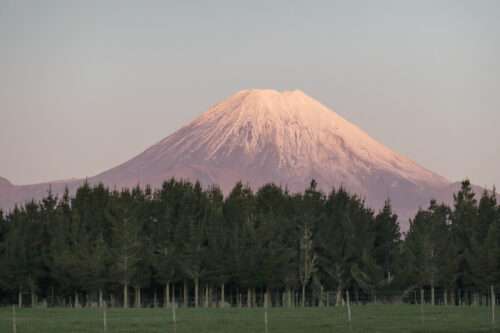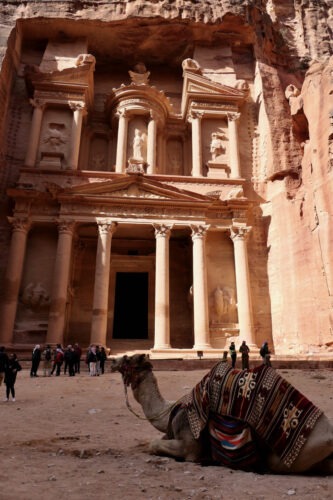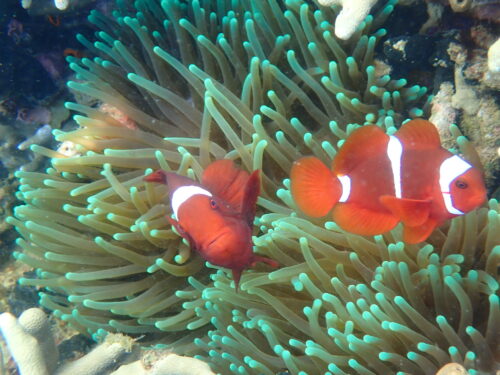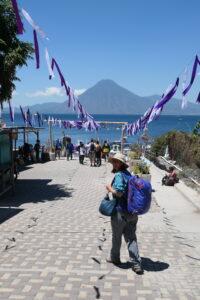Believe it or not, my husband and I had just 1 carryon suitcase and 1 normal-sized backpack each for our year off traveling the world together! How to pack for a year of traveling required a lot of thought! If we’d had more space, I would have bought souvenirs, which I didn’t really need. Traveling with only a carryon suitcase is absolutely essential if you’re taking more than one flight and spending time in more than one location. A big, heavy suitcase is too likely to get lost in airport travel, weigh you down when moving from place to place, and be too difficult to find a spot for on various trains/taxis/buses etc. Don’t do it!
Now, I did just join my first affiliate program, Amazon’s, because I want to put links on where to buy all of these items so that everything is easy for you to find. As an Amazon Associate I earn from qualifying purchases. However, I first wrote this article based on the items I actually own and travel with, and then I found them on Amazon because yes, Amazon does have everything. So if you find this article helpful, please do use the links here as it helps me make a bit of money from the time I spend writing these articles and you get the same price for products I’d honestly recommend. Thank you!
How to pack for two weeks, a month, or a year traveling!
Which suitcase?
You’re going to be spending a LOT of time packing up and unpacking. You want to think hard about how to transport your belongings.
Some people go for a backpacking suitcase, but if you go that route, you either need to get one that’s quite small for backpacking (see Which backpack, below) to be able to carry it on, or you’ll have to check it. I strongly discourage you from getting anything you’ll need to check in. If you have multiple flights, it will get lost sooner or later.
A suitcase has wheels, and when you’re walking many blocks from the train station to your hotel, you’ll really appreciate them. It also means your back is free to carry a backpack, and a normal-sized backpack is really useful.
What I look for in a suitcase:
- Extremely lightweight: Airlines have weight limits, and you don’t want to give up any of your precious weight on the suitcase itself. You have enough to carry already!
- Not breakable: You’re going to be putting it in the overhead bin, on trains and buses, and carrying it up flights of stairs. You don’t want it to crack! For this reason, I recommend a soft shell.
- A zippered compartment inside the suitcase big enough for some pieces of paper. You’ll want to pack photocopies of your passport, credit/debit cards, and immunizations just in case, so you’ll want a safe place to store them.
- Colorful! Don’t get a black or navy suitcase. Everyone else has one. It’s too easy for someone to genuinely accidentally take the wrong bag on a train/bus/plane if yours looks like everyone else’s.
Victor and I both bought IT Luggage because it was lightweight, sturdy, colorful, and had the compartments we needed. We used them during our year off traveling, and for several years before and after as well- and there’s not a single scratch on them. Here’s the Amazon link to use if you want one too! Several colors available, just make sure it says carryon, lightweight, and wheels. That link was to a blue one, this one is to a red one!
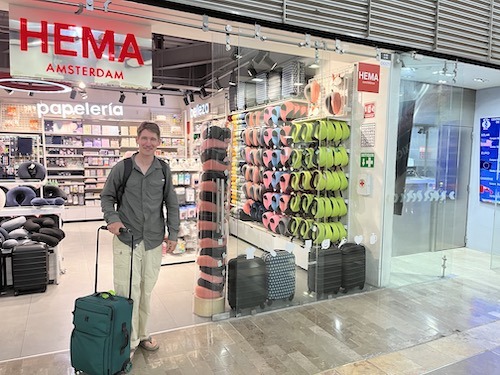

We also bought these luggage tags. Again, they’re brightly colored, so no one will take your bags by accident. They also make it clear that our bags have owners who care about them. We put one on our suitcase and one on our backpack. It was an extra layer of security that worked well for us.
Another tip: Please don’t pack your carryon suitcase and backpack stuffed! If you leave for a big adventure with an absolutely packed suitcase, you’re not going to be happy about it!
- Every time you pack up, it’s going to take a LOT of time and be stressful
- No matter what amazing things you find or end up needing, you won’t have room for them
- Packing up and unpacking will seem like a major chore, and if you have any strict airlines, it’ll be more stressful if your bags are overflowing and can’t squish into the compartments easily
So make your life easier, and don’t fill up your suitcase and backpack completely. Bring only items you really think you’ll use many, many times. If you really need something you don’t end up bringing, there are stores everywhere. You can find it wherever you’re going! You might be able to borrow or rent an item, or buy it at a Salvation Army and then give it back at the end of your trip.
We did all of those options on our year off: in New Zealand, it snowed when we were there, far colder than expected, and we borrowed, rented, and bought items as necessary. We rented one backpacking backpack for our multiday hikes in New Zealand, as well as the sleeping bags and other camping materials. We used my backpack as the other one (see below).
Which backpack?
Ok, I have many thoughts on which backpack you should buy, depending on how risk-adverse you are:
- I bought this backpack and LOVED it for our year off: Cotopaxi Allpa 35L. I found it because it’s the one the New York Times’ Wirecutter recommends. However, I used it in a way that they didn’t think of…it is the same size as a normal backpack, if you don’t stuff it too much. So whenever we flew, I took off the waist band (it fits inside the backpack), and I brought BOTH this backpack and my IT suitcase! That meant I had two suitcases. This was fantastic, and I never had any issues. You are allowed both a suitcase and a backpack…and this is a backpack that looks normal from the outside but inside is an extra suitcase!

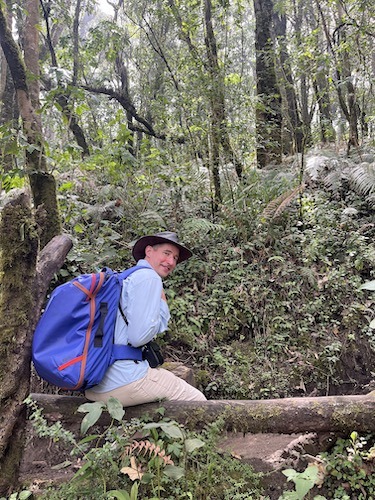
- Always, always check in online as soon as you’re able to. Checking in online means you don’t have to see any people until you’re at the gate, so no one has the chance to make you check any bags until you’re boarding. If you check in as soon as you can, you might be able to choose seats nearer the front and get to board earlier, also reducing the likelihood you’ll have to check any bags.
- Having the Cotopaxi Allpa was also useful for our multiday hikes, like in New Zealand, where we used that as a proper backpacking backpack. We did rent one bigger one there as well.
- I would suggest having 1 IT suitcase and 1 Cotopaxi Allpa 35L, and you’ll have plenty of space. However, if you pack very light and/or are more risk-adverse, then you can just bring any backpack you already own. Victor just brought a normal backpack he already had.
- Believe it or not, I was also able to fit a tiny day pack that folded up into a small bag with my stuff, which was really handy for day trips when I really just wanted to carry layers, water and sunscreen. This one I bought isn’t available anymore, but this one is, and it’s so cute! For the Inca trail, this size is all I needed to carry.
Specialized travel gear that’s worth buying
In general, of course it’s better to use stuff you already have at home than to buy new gear, especially items you might only use a few times. But these items I’d recommend buying if you don’t have already because they are game changers: they can make an enormous difference to your ability to enjoy your travels.
- Water filter: We bought this one because it filters out everything- viruses, bacteria, protozoa, heavy metals, pesticides, etc. We never drank directly out of it, but instead we bought 1 of these to filter water wherever we were and poured the safe water from it into our lightweight, easy to clean water bottles. Packing this water filter meant we never had to buy plastic water bottles or worry about when we would next be able to find safe water. Besides preventing plastic pollution, it was also far less stressful knowing we could make any water source safe whether or not we were near a store. We’d highly recommend this one. If you buy another brand, make sure it filters for anything you might be exposed to!
- Quick-drying clothes: In your everyday life at home, it doesn’t matter so much how quickly clothes dry. But when you’re traveling, and you get soaked, or you spill something, or fall in the mud, or need to wash something in the sink and leave a few hours later…it really helps if your clothes dry fast! Columbia sells good quality gear that dries fast. I packed three of these long sleeve shirts, two short sleeve shirts, and one pair of hiking pants that could change into shorts (pockets are really useful!). When we were in colder areas or I knew I was hiking many days in a row, I packed two pairs of hiking pants. I find pants too challenging to recommend to others so check out the Columbia store and see which quick-drying options work best for you!
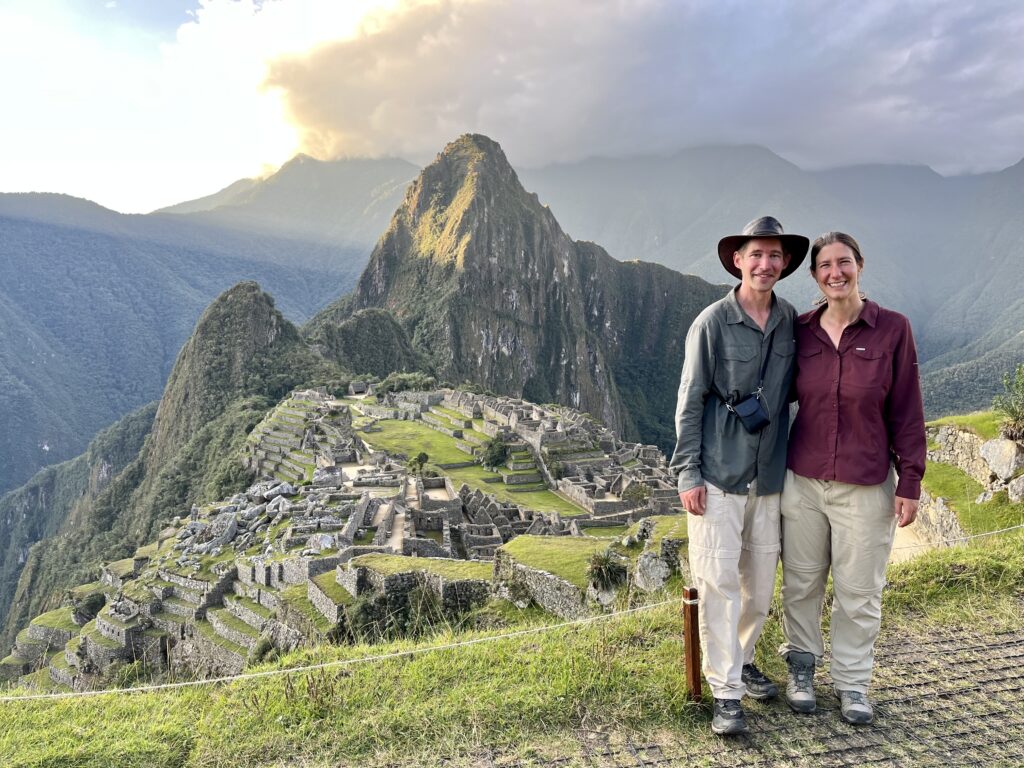
- Universal adapter: If you’re going to travel to several different continents in your lifetime, this is definitely a worthwhile investment. We only needed this one device to charge everything- our phones, cameras, backup chargers, headphones, etc. With the 4 USB areas and the actual plug, you can charge 5 devices at once anywhere in the world.
- Backup charger: This is essential when traveling, as you will need to navigate places using Google Maps, which will drain your phone battery fast. You do not want your phone to die when you’re traveling- your phone has your hotel address, your ability to call for directions or a taxi or public transit, your reservations…you cannot let your phone run out of battery! You need one that is small and light enough to carry with you at all times, because you’ll only need it when you don’t expect to. It should have the charging cables included and be able to charge at least twice, in case you’re on a multiday trip. This one does all of the above and is recommended by Wirecutter. If you have an older iPhone, this backup charger will work for you, comes in fun colors, and has the charging cables included as well! This is the brand I have.
- A lightweight fleece like this one.
- A lightweight rain jacket– I got this one because the NY Times Wirecutter recommended it, and it was SO useful on our year off. We avoided rainy seasons whenever possible, but sometimes of course it rains anyway (like year round in New Zealand!). It takes up so little space, protects you thoroughly from the rain and wind, weighs nothing, and comes in lots of fun colors. I use it in normal life too! My husband got the men’s version here.
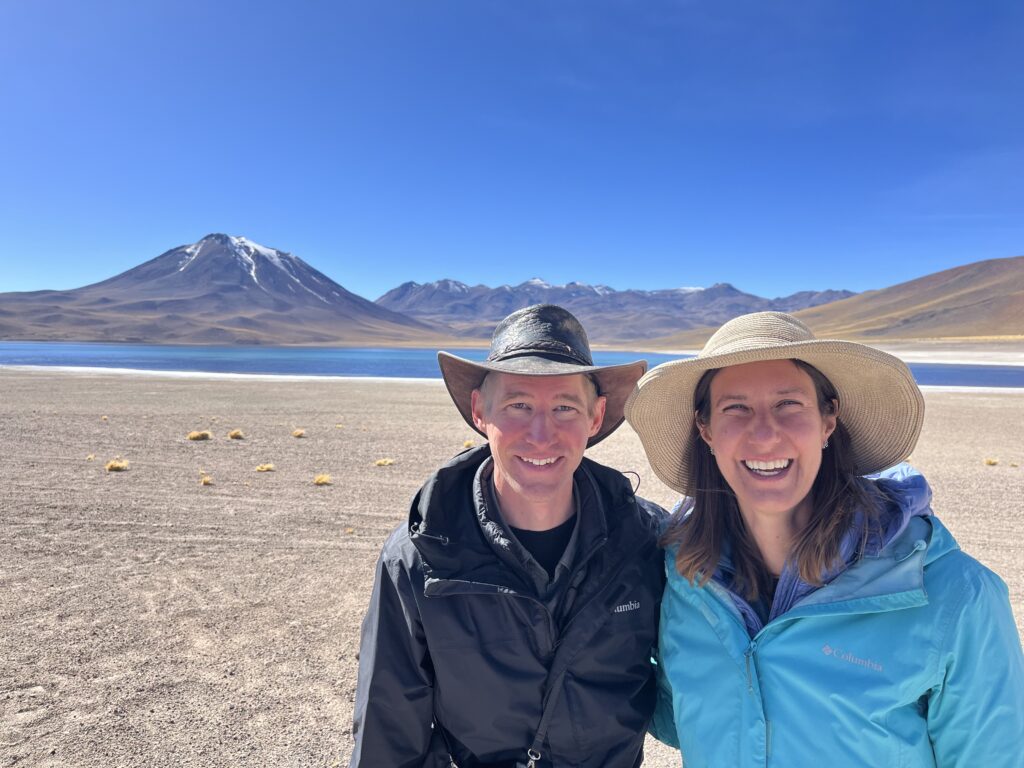
- Kindle– I love reading, and reading real books is better. However, if you’re going to take a year off, or travel for anything more than a week or two, and you are a reader- you need an e-reader. First, make sure you have a valid library card. Next, on your home library’s website, figure out how to set up digital loans to a Kindle (or whichever e-reader you want to buy). I got a Kindle paperwhite as a wonderful gift 9 years ago, and have been using it ever since, getting books from my public library for free this whole time while living abroad! I like that it does nothing besides books (no internet browsing), no notifications, and reads like printed text. Now, I can travel with dozens of books that weigh nothing!
- Excellent quality hiking shoes that you wear as much as possible before traveling! I got the ones linked and wore them during our whole year off- and all of our adventures since then. This is what I’d look for:
- Waterproof: It will rain, you will walk through puddles, rivers, mud, and all sorts of messes. Wet socks are miserable, and shoes that aren’t waterproof never dry out. Pay extra for waterproof!
- For me, high ankle support: Personally, I turn my ankles fairly regularly when hiking if I’m not wearing shoes that have good ankle support. My husband never does, so he didn’t need this. But if you ever do, make sure your hiking shoes cover your ankles because a turned ankle can ruin an entire trip! On an earlier trip before our year off, I rolled my ankle at the top of the Dolomites and Victor had to help me slowly all the way down…and we missed the last bus back! Never again!
- A reliable brand: I walked an average of about 15,000 steps during our year off- and many days were 20,000-30,000, up and down mountains. This is not an area to save money. I wore these shoes in freezing temperatures, in downpours, in boiling heat and humidity, in mud and walking through rivers. Buy from a brand that is known for quality hiking gear like Salomon’s.
- My husband bought Hoka’s because they work better for his feet. Hoka’s are famously lightweight and good for people who might need more serious cushioning, support, special insoles, or other foot needs. He bought waterproof ones, and they were super comfortable and lightweight, and worked wonderfully for our year off…but they are not durable. With our intensive year, they were worn out, while my Salmon’s look like new and should last another 10 years.
- Whatever you get, try them on in advance, and buy ones with a good return policy. Try them out as much as you can to see whether they really work for you!
- Teva sandals: I’ve owned Teva sandals for decades now, and each pair has lasted at least 10 years! They are waterproof, extremely durable, comfortable, and with excellent grip. I’ve climbed up mountains, sand dunes, through marshes and rainforest, deserts and canyons with my Tevas. My husband too. It’s so important to have waterproof sandals to give your feet a break from the hiking shoes, and you want them to be sturdy enough to walk long distances in- otherwise you’ll have to wear the hiking shoes every day. I brought two different styles with me on our year off so that my feet didn’t get too uncomfortable with one shoe or the other. I had one black and white in this style and one pale blue in this style, so they would go with all the clothes I brought. Just pack colors and styles that go with your clothes (and men, they have plenty of options for you too!).
- High quality hiking socks: I followed the NY Times Wirecutter’s recommendations for this too, and I was so glad I did. Remember to try on your favorite hiking socks with your hiking shoes before traveling! These socks went with me on all those multiday hikes, and they didn’t smell bad in all these crazy circumstances! I didn’t get blisters on the Inca trail, Colca Canyon, the Great Walks, and all the other long hikes we did, and these socks made it all possible. These are the ones for men. I know they’re expensive, but you only need 2-3 pairs, because they dry so quickly, smell so little, and are such good quality. It was worth it!
- A credit card with zero foreign transaction fees! This is absolutely essential if you’re traveling abroad for more than a couple of weeks a year. Every single time you pay for anything abroad, you always want to pay in the local currency (sometimes companies will ask you which currency you want- do NOT say your home currency, say the local one!). If you pay in your own currency instead of the local one, the exchange rate will be terrible- you’ll lose a few dollars every time (or more if it’s a big purchase). On the other hand, if you don’t have a special credit card that gives you no transaction fees for paying in another currency, you’ll also lose a percentage of each purchase to your own bank- often 1%-3% of your purchase!
- This referral code is for the credit card I’ve been using while living abroad: the Chase Sapphire Preferred card. If you use this code, I got 10,000 points and you get up to $750 back if you spend $3,000 in the first 3 months! I really did get that $750 when I first signed up, and you can too.
- It also includes car rental insurance, which will save you money.
- The points I’ve earned by using this credit card paid for our entire rental car for a month in New Zealand, as well as several flights on our year off. You’ll need a credit card while traveling. Choose one that won’t cost you money when using foreign currencies- and one that gives you points for travel purchases and extra points for spending the points on travel!
- A debit card with no ATM fees: You’ll need to talk with your bank about this one. When we did our year off, I was with First Republic, which had zero ATM fees. Sadly, First Republic no longer exists. I’ve been in discussions with my bank about maintaining that benefit that made such a difference for me. When I have a bank I can confidently refer, I will. In the meantime, talk with your bank about whether they have a plan that allows this! Some places we went to, like Indonesia and Peru, had $7 to $10 fees every time we had to withdraw cash…and only allowed us to withdraw about $50 at a time!
How to pack as a woman
I know not all women are going to want to pack these items, but these are some items that I found really useful in my carryon suitcase on our year off.
For all clothing I packed, I had a few rules:
- I only brought clothes that covered my shoulders, and the only item that showed my knees were the shorts that I could make from my hiking pants. First of all, shoulders get burned easily, because if you wear a backpack, the sunscreen rubs off. Secondly, there are so many times when you won’t be able to have bare shoulders- religious buildings, conservative towns, mosquitoes, times when you can’t properly shower/shave, it’s just too inconvenient.
- I only brought clothes that all went together. So every shirt could go with every bottom and each pair of shoes/sandals, so I had the most variety I could with as few items as possible.
- I brought fun, not expensive jewelry that matched with every outfit to make my outfits look different- but no jewelry that wasn’t replaceable or looked worth stealing!
- I didn’t bring anything white, as it’s too likely to look stained/sweaty/dirty too quickly. I brought colorful tops and grey/tan bottoms to match everything while still having fun and variety.
Specific items that I’m glad I made room for in my carryon suitcase:

- One dress: I loved having one lightweight packable summer dress in my carryon suitcase. I spent more than 90% of our year off wearing hiking pants and hiking shirts, but every once in a while, when we were in a town and going to a delicious meal, it felt really lovely to change into a (relatively) clean dress. The photo is after we did the Lost City (Cuidad Perdida) hike in Colombia, so I’d been wearing muddy, sweaty hiking gear the previous 4 days. It was wonderful to shower, change into a clean summer dress, and have a well-deserved meal with a view in Cartagena afterwards!
- One skirt: Again, I wore hiking pants almost every day…but every once in a while, in the towns, going out to dinner it was nice to feel a bit fresher and not wear the same thing I’d just hiked in. Mine was grey, so it went with all my colorful shirts. If you could find a pattern that goes with all your tops that would work well too.
- Period gear: It’s not always easy to find pads/tampons when traveling, and can be extremely difficult/awkward to dispose of them. On our year off, I used Thinx period underwear– you can just cold water wash them in a washing machine or in the sink. I needed them on several multiday hikes, and I don’t know what I would have done otherwise as there was sometimes no place to dispose of sanitary napkins/tampons. Definitely try out different options at home and have a plan!
- Quick drying underwear: For my bachelorette, my girlfriends got me travel underwear, which was honestly the perfect gift for me. It was such a treat to have underwear that dries so quickly so it was easy to wash in a sink…and just so comfortable when hiking in hot, humid places!
- A travel purse: This is a special anti-theft travel purse that I’ve carried all over the world. It’s helpful to keep it small so it doesn’t get too heavy, as it’s much better to carry weight with a proper backpack than a purse. But when we’re going around a city, it’s nice to carry your money, keys, and phone without bringing a whole backpack. You can pack the purse in your carryon suitcase, or I’ve also gotten away with bringing it separately with my kindle, passport, and phone and putting everything else up in the overhead compartment!
- Secure money belt to hold your passport and at least 1 extra credit card and ideally 1 extra debit card (if traveling with 2 people, keep at least 1 debit card separate from the other). Either this style or this style, whichever one you’ll actually use! I know it’s awkward, but you really can’t walk around with your passport in something so obvious as a purse or a backpack. It’s too easy, and the consequences of losing your passport are too drastic. When you get to your hotel, find a place to leave your passport there- a safe, for example. You don’t need to take your passport with you on your hike or city adventure. But when you are going from your plane/train/bus to your hotel, or on the plane/train/bus, you need to keep your passport and at least 1 credit/debit card safe in case you get pickpocketed. We never did in our year off, but you need to be prepared.
Your packing list
Okay, let’s start packing! Here’s everything I’d recommend, all with Amazon affiliate links when possible so that I can earn a bit of money while you still get the products I’d most recommend. Thanks for using these links! These are all items that I actually own and used on our year off and continue to use today!
How to pack for your year off:
- Water bottle filter
- 1 very easy to clean water bottle
- IT suitcase
- 3 lightweight, quick drying long sleeve shirts
- 2 lightweight, quick drying short sleeve shirts
- 1 lightweight fleece like this one
- 1 scarf
- 1 warm hat
- 1 sun hat
- 1 warm long sleeve underlayer
- 1 lightweight rain jacket
- 2 lightweight hiking pants that go with all your shirts, 1 of which can be made into shorts
- 1 skirt below the knees that won’t wrinkle and goes with all your shirts (black, grey, beige, etc.)
- 1 wrinkle-free summer dress that covers shoulders and knees, if you would enjoy
- Kindle or other e-reader with books loaded on and charger
- 1 pair of excellent quality hiking shoes you have walked in before, ideally lightweight
- 1 pair of excellent quality hiking sandals, like these Tevas
- Optional pair of shoes if space: slippers, comfy sandals, very light shoes
- 4-5 pairs of high quality wool socks
- 4-5 pairs of underwear. Consider high quality quick-drying travel underwear. If relevant, consider period underwear or bring enough tampons/pads for a few days in case they’re difficult to find. I found period underwear the easiest option for our year traveling.
- Guidebook- Rick Steves if it’s Europe, otherwise I haven’t found a favorite yet. My website!
- Backpack
- Travel purse
- Phone charger
- Universal adapter
- Backup charger
- Wallet with at least 1 credit card and 1 debit card
- Credit card should have zero foreign transaction fees
- Debit card that will refund your ATM fees
- Secure money belt to hold your passport and at least 1 extra credit card and ideally 1 extra debit card (if traveling with 2 people, keep at least 1 debit card separate from the other). Either this style or this style, whichever one you’ll actually use!
- Passport that will not expire for the next 6 months or more and has plenty of blank pages. If close, renew now!
- Toiletries: Of course all in 100ml/3 oz. travel containers! Different color containers or labeling them in permanent marker is helpful: I’d definitely have 1 for shampoo, 1 for soap, and 1 for sunscreen!
- Sunscreen (high quality might be hard to find abroad, bring enough!)
- Insect repellent (can be hard to find abroad)
- Anti-inch cream
- First aid ointment
- Bandaids
- Soap (liquid- and refill as needed!)
- Shampoo (liquid- and refill as needed!)
- Pepto (having 1 after each meal can reduce the likelihood of traveler’s diarrhea!)
- Ibuprofen (Motrin) or Aleve
- Paracetamol (Tylonel)
- Cold medicine especially for flying safely and sleeping (like Afrin nasal spray)
- TONS of Kleenex (for emergency toilet paper!)
- Hand sanitizer (again, when no proper bathroom is available)
- Chapstick with SPF (essential in high altitudes/tropical areas)
I think that’s how to pack for a year off with just one carryon suitcase! If I’ve forgotten anything, let me know in a comment. Have a wonderful adventure!

